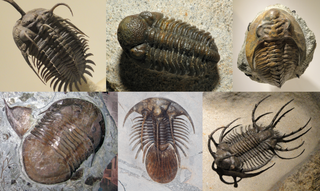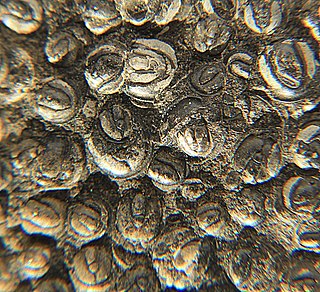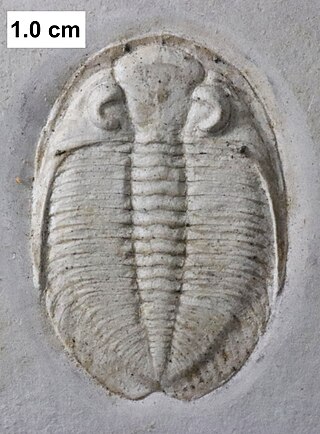
Trilobites are extinct marine arthropods that form the class Trilobita. Trilobites form one of the earliest known groups of arthropods. The first appearance of trilobites in the fossil record defines the base of the Atdabanian stage of the Early Cambrian period and they flourished throughout the lower Paleozoic before slipping into a long decline, when, during the Devonian, all trilobite orders except the Proetida died out. The last trilobites disappeared in the mass extinction at the end of the Permian about 251.9 million years ago. Trilobites were among the most successful of all early animals, existing in oceans for almost 270 million years, with over 22,000 species having been described.

The Furongian is the fourth and final epoch and series of the Cambrian. It lasted from 497 to 485.4 million years ago. It succeeds the Miaolingian series of the Cambrian and precedes the Lower Ordovician Tremadocian Stage. It is subdivided into three stages: the Paibian, Jiangshanian and the unnamed 10th stage of the Cambrian.

Paradoxides is a genus of large to very large trilobite found throughout the world during the Middle Cambrian period. One record-breaking specimen of Paradoxides davidis, described by John William Salter in 1863, is 37 cm (15 in). The cephalon was semicircular with free cheeks ending in long, narrow, recurved spines. Eyes were crescent shaped providing an almost 360° view, but only in the horizontal plane. Its elongate thorax was composed of 19–21 segments and adorned with longish, recurved pleural spines. Its pygidium was comparatively small. Paradoxides is a characteristic Middle-Cambrian trilobite of the 'Atlantic' (Avalonian) fauna. Avalonian rocks were deposited near a small continent called Avalonia in the Paleozoic Iapetus Ocean. Avalonian beds are now in a narrow strip along the East Coast of North America, and in Europe.
The Paibian is the lowest stage of the Furongian Series of the Cambrian System. The Paibian is also the first age of the Furongian Epoch of the Cambrian Period. It follows the Guzhangian and is succeeded by the Jiangshanian Stage. The base is defined as the first appearance of the trilobite Glyptagnostus reticulatus around 497 million years ago. The top, or the base of the Jiangshanian is defined as the first appearance of the trilobite Agnostotes orientalis around 494 million years ago.

Agnostus is a genus of agnostid trilobites, belonging to the family Agnostidae, that lived during the late Middle Cambrian – early Upper Cambrian. It is the type genus of the family Agnostidae and is subdivided into two subgenera, Agnostus and Homagnostus.

Analox Rasetti, 1966 is a genus of Eodiscinid trilobites belonging to the family Weymouthiidae Kobayashi T. (1943), Order Agnostida It lived during the Botomian stage. It can easily be distinguished from other trilobites by the two furrows that extend forwards and sidewards from the front of the glabella.
Meniscuchus is an extinct genus from a well-known class of fossil marine arthropods, the trilobites. It lived during the Botomian stage, which lasted from approximately 522 to 516 million years ago. This faunal stage was part of the Cambrian Period. Meniscuchus has been found in the USA, Canada, Russia and Australia.

Meteoraspis is an extinct genus of ptychopariid trilobites of the family Tricrepicephalidae. The various species lived from 501 to 497 million years ago during the Dresbachian faunal stage of the late Cambrian Period. Fossils of Meteoraspis are characteristic of Late Cambrian strata in North America, though they are found in Late Cambrian strata elsewhere in the world, such as M. nevensis from Victoria Land, Antarctica.

Fallotaspis is a genus of redlichiid trilobites found in Early Cambrian-aged strata of the United States and Morocco.

Buenaspis is a genus of small nektaspid arthropod, that lived during the early Cambrian period. Fossil remains of Buenaspis were collected from the Lower Cambrian Sirius Passet Lagerstätte of North Greenland. Buenaspis looks like a soft eyeless trilobite. It has a headshield slightly larger than the tailshield (pygidium), and in between them six thoracic body segments (somites). The genus is monotypic, its sole species being Buenaspis forteyi.
Bolbolenellus is an extinct genus of trilobites, fossil marine arthropods, with five species attributed to it currently. It can be easily distinguished from all other trilobites by the combination of the absence of dorsal sutures in the head shield like all Olenellina, and a distinctly bulbous frontal lobe (L4) of the raised axial area in the head called glabella. The species lived at the end of the Lower Cambrian.
The Jiangshanian is the middle stage of the Furongian series. It follows the Paibian Stage and is succeeded by the still unnamed Stage 10 of the Cambrian. The base is defined as the first appearance of the trilobite Agnostotes orientalis which is estimated to be 494 million years ago. The Jiangshanian lasted until approximately 489.5 million years ago.
The Guzhangian is an uppermost stage of the Miaolingian Series of the Cambrian. It follows the Drumian Stage and precedes the Paibian Stage of the Furongian Series. The base is defined as the first appearance of the trilobite Lejopyge laevigata around 500.5 million years ago. The Guzhangian-Paibian boundary is marked by the first appearance of the trilobite Glyptagnostus reticulatus around 497 million years ago.
The Wuliuan stage is the fifth stage of the Cambrian, and the first stage of the Miaolingian Series of the Cambrian. It was formally defined by the International Commission on Stratigraphy in 2018. Its base is defined by the first appearance of the trilobite species Oryctocephalus indicus; it ends with the beginning of the Drumian Stage, marked by the first appearance of the trilobite Ptychagnostus atavus around 504.5 million years ago.

Lejopyge laevigata is a species of agnostid trilobite belonging to the genus Lejopyge. It existed during the Guzhangian to the Paibian Age of the Cambrian. It has a cosmopolitan distribution and is an important index fossil in biostratigraphy.

The Miaolingian is the third Series of the Cambrian Period, and was formally named in 2018. It lasted from about 509 to 497 million years ago and is divided in ascending order into 3 stages: the Wuliuan, Drumian, and Guzhangian. The Miaolingian is preceded by the unnamed Cambrian Series 2 and succeeded by the Furongian series.

Glyptagnostus reticulatus is a species of agnostid trilobite belonging to the genus Glyptagnostus. It existed during the Paibian Age of the Cambrian. It has a cosmopolitan distribution and is an important index fossil in biostratigraphy. It was characterized by an unusual net-like pattern of furrows on both the cephalon and the pygidium.

Tricrepicephalus is an extinct genus of ptychopariid trilobites of the family Tricrepicephalidae with species of average size. Its species lived from 501 to 497 million years ago during the Dresbachian faunal stage of the late Cambrian Period. Fossils of Tricrepicephalus are widespread in Late Cambrian deposits in North America, but is also known from one location in South America. Tricrepicephalus has an inverted egg-shaped exoskeleton, with three characteristic pits in the fold that parallels the margin of the headshield just in front of the central raised area. The articulating middle part of the body has 12 segments and the tailshield carries two long, tubular, curved pygidial spines that are reminiscent of earwig's pincers that rise backwards from the plain of the body at approximately 30°.
Agnostotes is a genus of artiopodan arthropod in the family Diplagnostidae of the order Agnostida. It was a widely distributed genus.

Waukeshaaspis is an extinct genus of trilobite known from the lower Silurian aged Waukesha Biota. A single species is currently known, Waukeshaaspis eatonae, which is known from strata belonging to the Telychian aged Brandon Bridge Formation in Wisconsin. Originally discovered alongside the Waukesha Biota in 1985, this genus wouldn't be properly described until 2024. Currently, this genus is placed within the family Dalmanitidae, within the larger Phacopida, which lasted from the Lower Ordovician to the Upper Devonian.












